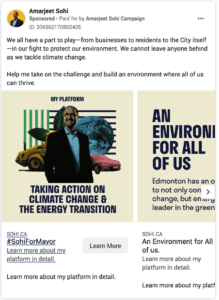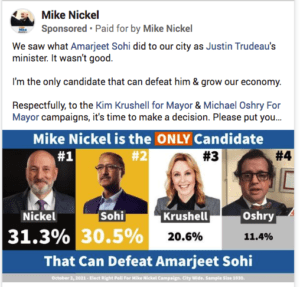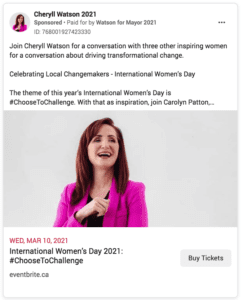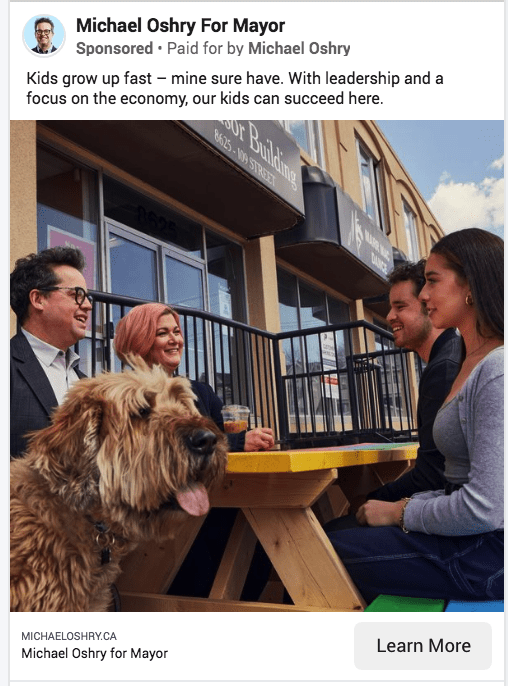As the mayoral campaigns are coming to a close, and Edmontonians are heading to the polls today, we wanted to take a closer look at the different strategies for social media advertising campaigns of all the candidates. After our recent CBC interview, we wanted to write a follow-up to see how the campaign strategies evolved as we headed into the home stretch of the campaign.
Which candidate started first?
Mike Nickel began his campaign as early as February of this year with ads trying to build his profile numbers by asking for follows and likes. the ad primarily was targeting males and 25+ females.
Cheryll Watson also began campaigns in early February with more brand and awareness based ads, trying to inform the public about her background and achievements. These ads were targeted to anyone 18+, but showed a definitely leaning towards woman.
Amarjeet Sohi’s campaign didn’t start on social media channels until late June – quite a stark difference when compared to his competitors. This may be an indication of brand recognition as Amarjeet had been involved in politics in Edmonton for some time. This first ad was only targeted towards women in the age range of 25-54, and was built to drive volunteers to help support his campaign.
Michael Oshry’s campaign started very early in June with awareness ads designed to help educate Edmontonians on his Edmonton roots (and connection to Remedy Cafe), and his vision for this cities future. Interestingly, these ads were targeted only to 35+ individuals.
Who had the best head start?
Hands down this contest went to Amarjeet Sohi, who had already amassed a huge social following with over 10k+ on Facebook and 8k+ on Instagram. Considering his long-standing career in Canadian and local politics, this head start allowed him to have solid reach with an engaged population through organic content, whereas many of his competitors were starting from scratch, or with a smaller loyal following.
Mike Nickel has been involved in local politics since 2013 when he was elected councillor for Ward 13. He has been slowly building his following in Edmonton since this time, with a large boost in advertising spending (the highest of any candidate) for the 2021 mayoral campaign.
Cheryll Watson first made her social profiles in November 2020, and has steadily been spending and increasing her fan following and reach with Edmontonians, but was far behind other candidates with around 1k followers on Facebook & Instagram collectively.
Michael Oshry’s only first made his Facebook page on May 10th, indicating a tough road ahead to gain a following on the platform.
What approach has each candidate took?

Amarjeet Sohi’s Campaign Review
Amarjeet Sohi has a comprehensive social campaign that includes promotions and organic content. The overall pace of his campaign has been rather quick, from his late June start to today, he’s spent around $16k. His messaging has taken the following progression:
- Call for volunteers, donations and support
- Community Support & Involvement
- Pillars of Campaign
- Final Drive For Support
Amarjeet did not run any attack ads throughout his campaign.
Mike Nickel Campaign Review

Mike Nickel’s campaign started early with many grassroots posts and ads promoting awareness of how he feels on particular hot-button issues in Edmonton. It was definitely an appeal to garner conversations and discussions. He also posted the most diverse range of content and topics of any candidate. Nickel spent the most money of any candidate, spending well over $35k for this election on Facebook. Here’s the overall progression of his campaign:
- Grass Roots on-site type messaging
- Hot-button issues and his position
- Comparative ads & attack ads on competitors
Mike’s campaign approach also garnered some criticism for his attack ads prompting potential censure and sanctions. He chose to brazenly hit back with an ad trying to spin the messaging.
Cheryll Watson’s Campaign Review
 Cheryll Watson’s campaign appeared to be largely focused on the women’s population of Edmonton with a variety of campaigns targeting younger demographics and others of all ages. As her campaign progressed she began also targeting men. As a new candidate, she had an uphill climb for awareness and brand building on her platform, but was able to spend close to $9k in her promotion. Cheryll didn’t run any attack ads. I personally feel she could have used more video of her speaking directly to Edmontonians. Most of her ads were were static images, or used static images in video, so really getting to know her as a candidate was difficult through these ads. Here’s her overall progression:
Cheryll Watson’s campaign appeared to be largely focused on the women’s population of Edmonton with a variety of campaigns targeting younger demographics and others of all ages. As her campaign progressed she began also targeting men. As a new candidate, she had an uphill climb for awareness and brand building on her platform, but was able to spend close to $9k in her promotion. Cheryll didn’t run any attack ads. I personally feel she could have used more video of her speaking directly to Edmontonians. Most of her ads were were static images, or used static images in video, so really getting to know her as a candidate was difficult through these ads. Here’s her overall progression:
- Grass-roots awareness, meeting locals through Q&A sessions
- Lawn signs as a show of support
- Positions on policy and changes she’d implement
- Final push for awareness
 Michael Oshry’s Campaign Review
Michael Oshry’s Campaign Review
Michael Oshry ran a rather large campaign on Facebook & Instagram with over $11k spent across the platforms. He didn’t have the most diverse set of ad offerings, when compared to the other candidates, as he tended to promote the same ads for longer. That said, he had a wide range of different topics, used a lot of video ads and many of which targeted towards homeowners and parents of kids. Interestingly, he was advertising heavily to Edmontonians aged 35+ throughout September, but turned off all ads a few days prior to the election on the 15th of October. Michael didn’t run any attack ads. Here’s his overall progressions:
- Grass roots awareness and local photo shoots
- Campaign policies push
In Conclusion
It was fun to analyze the social media spends of the varying candidates in our city’s mayoral campaign. While this really only provides us a glimpse into their marketing strategy, as we’ve tried to show, there’s still something to be learned. Marketing is far more than simply advertising on Facebook, so its hard to say what kind of role this will play in the overall impact of the election. On top of that, the data that we can glean from Facebook is limited to the data provided by the platform to the public, so take our results here with a grain of salt. We also acknowledge we didn’t cover all candidates in this post, the main reason being their spend was too low to really garner any insights into their overall strategies for the platform. In the end, we love data, and had fun reviewing and analyzing what we could to make this post. We wish the best to all candidates, and are excited to see who wins the 2021 Edmonton Mayoral Election.
Recent Posts
Navigating the Digital Buying Cycle: Strategies for Modern Consumers
In today’s fast-paced world, where information is just a tap away, the buying cycle has transformed dramatically. Gone are the days when consumers...
Digital Marketing Strategies in the Off-Season
Ah, the off-season. For some businesses, it’s a time to kick back, relax, and sip on a well-deserved latte. For others, it’s a...
How ChatGPT is Transforming Online Search Behaviour
In the ever-evolving landscape of digital information, the way we search for answers is undergoing a seismic shift. We got used to searching...



